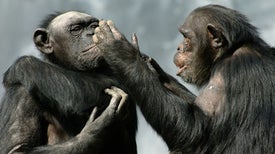
In the forest close to Wamba, a village within the Democratic Republic of the Congo, a few of the final remaining bonobos breed, feed and lounge within the bushes. Like different nice apes, these animals have a wealthy social life, speaking with their fellows utilizing some 80 forms of gestures. Primatologist Kirsty Graham of the University of St. Andrews in Scotland has spent a whole lot of hours amongst this screeching, scratching endangered troupe to decode its members’ nonverbal interactions. This work has confirmed, for instance, that when one of many animals repeatedly swipes the black fuzz on its chest, it’s begging to be groomed. And when it cups its hand underneath one other’s chin, it’s asking for meals.
Graham’s St. Andrews colleague Catherine Hobaiter constructed an identical body-language dictionary by observing the East African chimpanzees on the Budongo Central Forest Reserve in Uganda. The gestures of each species, that are people’ two closest kinfolk, are extra complicated and assorted than their vocalizations, which primarily mirror pressing wants resembling discovering meals or recognizing predators.
By distinction, the apes’ gestures function a deliberate means of conveying particular on a regular basis targets, main some scientists to consider that these alerts are the precursors to human language. “They are using gestures in a way that is more languagelike, and so there’s this theory that human language might have evolved from this gestural basis,” Graham says.
In a paper revealed right now in PLOS Biology, Graham and Hobaiter present startling proof that this ancestral capability might persist in fashionable people. They present that our species could make a reasonably good guess of the meanings of chimp and bonobo gestures, one other trace that language might have advanced from an elaborate system of hand and physique alerts.
In the examine, when hundreds of individuals watched on-line movies of untamed apes elevating an arm, scratching and hanging numerous poses, they got the gist of the animals’ lingo way more usually than could be anticipated by likelihood. “Humans without any training and without seeing any of the outcomes or surrounding behaviors can understand what chimpanzee and bonobo gestures mean,” Graham says.
The discovering means that people nonetheless have some grasp of this ancestral vocabulary. “Maybe this is something that was shared with our last common ancestor and that we, in fact, retain, this ability to understand and use the great ape gestures,” Graham says.
The work fills a gap within the case for a shared linguistic lineage. Scientists have realized that nice ape vocabularies overlap extensively: about 95 p.c of bonobos’ gestures are the identical as these chimpanzees use. What’s extra, in a 2019 pilot examine, Hobaiter and her colleagues discovered that the overwhelming majority of gestures used by toddlers younger than two years old, who don’t but primarily use spoken or signal language to speak, are the identical as these of chimpanzees.
But it has been troublesome to search out any such gestural overlap between wild apes and people as soon as the latter attain maturity. Adult human communication is dominated by spoken or signal language, along with a huge variety of gestures, a lot of that are culturally particular. “Unpicking whether we still have access to that great ape gesture communication is really difficult just by observing people,” Graham says.
A technique to deal with this query got here to Graham and Hobaiter a number of years in the past, as they had been amassing and analyzing ape movies. The researchers deciphered the that means of every ape gesture by taking a look at what occurred after. For occasion, if an ape bent its again knee and raised its foot, after which its youngster hopped on its again, they could conclude that the foot elevate meant “I’ll give you a ride.” The decoding course of took years and concerned sifting by hundreds of examples of such behaviors. But all alongside, the scientists had a way that they only obtained what the animals had been saying. “We are putting all of this time into understanding them,” Graham says, “but always in back of our minds, it was like, ‘We know what the gestures mean.’”
What the researchers didn’t know was whether or not atypical individuals who didn’t spend massive components of the 12 months hanging out with apes had the identical instinct. In 2017 Graham and Hobaiter determined to search out out. They designed what they anticipated to be a small pilot examine by which lay individuals would attempt to determine chimp gestures from movies in a web based quiz. Each test-taker was proven 20 brief clips of chimps or bonobos making gestures and requested to determine which of 4 doable solutions described every gesture’s that means. In one of many clips, a bonobo gave its comrade a shove. In this case, the animal was saying, “Climb on my back.” But when a chimp did the identical, it was telling its companion to maneuver to a brand new spot.
After the media picked up the workforce’s work, greater than 17,000 individuals logged on to watch the videos. The researchers excluded contributors who didn’t watch all of the clips, who noticed the clips greater than as soon as or who stated that they had expertise with primates, leaving 5,656 scores. “It’s a really impressive piece of citizen science,” says Erica Cartmill, an anthropologist on the University of California, Los Angeles, who was not concerned within the examine. “The number of people that they have looking at ape gestures is fantastic.”
If individuals had no thought what the apes had been doing, they’d be proper 25 p.c of the time by likelihood, appropriately selecting one of many 4 solutions. But the typical rating was barely above 50 p.c, a statistically sturdy end result, given the examine’s measurement. “What is interesting is that people seem to be able to do [this task], and somehow their guesses, while not being perfect, are definitely above chance,” says Federico Rossano, a comparative psychologist on the University of California, San Diego, who was not concerned within the examine. Humans’ capability to make sense of the behaviors of pets, resembling cats and canine, is extra restricted, he says. “Some people are very good at interpreting pets, but many others are not,” Rossano says. “Indeed, you might get bit.”
The examine contributors even understood ambiguous ape gestures, these with multiple doable that means in ape society, with one exception: When a chimp shakes an object resembling a department, it usually means “Let’s have sex,” but it surely may imply “Move away from me,” relying on the context. People picked the proper that means for this gesture, which the researchers known as “object shake,” no higher than likelihood. And usually, accuracy charges within the examine assorted fairly a bit by the kind of gesture. “That tells you that things that are very specific to the language of the chimps, we don’t [understand],” says Thibaud Gruber, a primatologist on the University of Geneva, who was not concerned within the examine.
But the achievement of the check takers shouldn’t be underestimated. Apes get vital context for deciphering ambiguous gestures by dwelling with each other. “Given that people don’t get any of that in these videos, it is really striking that they can still understand the gestures,” Graham says.
Why people might perceive the ape gestures stays to be found. The human and chimp lineages are separated by as much as six million years. One chance is that every one nice apes, together with people, inherit a typical set of gestures. Another is that people and different nice apes share the power to make use of physique actions as communication instruments, what Graham calls “embodied communication.”
A 3rd clarification is that the similarity in physique form amongst people and different nice apes, mixed with people’ cognitive skills, makes it straightforward for individuals to deduce that means from ape actions. The examine leaves these potentialities unresolved, Cartmill says. She calls the work “a beautiful first step” exhibiting that people can acknowledge the intent and that means of the communications of one other species. But she wonders, “Is this because we are very good at making inferences, or is it because there is some common underlying gestural system?”
“I believe gesture had a strong role to play in the evolution of language,” Cartmill continues. “I think this paper contributes to that story and helps open up new possibilities of there being either a deep-rooted set of gestures or a deep-rooted sensibility to seeing, perceiving and understanding gesture.”
But Rossano shouldn’t be satisfied that people and different nice apes share an innate repertoire of gestures. “Humans can recognize the meaning of a bark from a dog or the roar of a lion as a threat, yet this does not mean we share barking or roaring with them as a communicative tool,” he stated.
Even if Rossano is correct, the examine itself nonetheless has its personal worth as a instructing device. Engaging so many individuals with this analysis has advantages past the science, Gruber says. “What is really cool is the methodology and how people engaged with it,” he says. “That makes them understand ‘Oh, we’re so really close with our closest relatives.’ That, for me, is a win. It’s a win for conservation. It’s a win for showing how important it is to keep these guys in our mind, to protect them, to save them.”













Discussion about this post